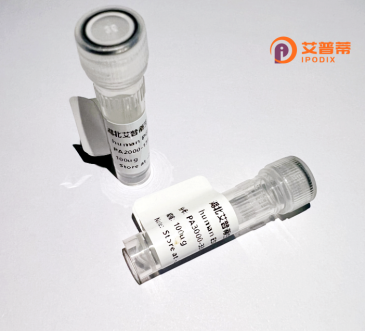
| 纯度 | >90%SDS-PAGE. |
| 种属 | Human |
| 靶点 | PPP2R5A |
| Uniprot No | Q15172 |
| 内毒素 | < 0.01EU/μg |
| 表达宿主 | E.coli |
| 表达区间 | 2-486 aa |
| 活性数据 | SSSSPPAGAASAAISASEKVDGFTRKSVRKAQRQKRSQGSSQFRSQGSQAELHPLPQLKDATSNEQQELFCQKLQQCCILFDFMDSVSDLKSKEIKRATLNELVEYVSTNRGVIVESAYSDIVKMISANIFRTLPPSDNPDFDPEEDEPTLEASWPHIQLVYEFFLRFLESPDFQPSIAKRYIDQKFVQQLLELFDSEDPRERDFLKTVLHRIYGKFLGLRAFIRKQINNIFLRFIYETEHFNGVAELLEILGSIINGFALPLKAEHKQFLMKVLIPMHTAKGLALFHAQLAYCVVQFLEKDTTLTEPVIRGLLKFWPKTCSQKEVMFLGEIEEILDVIEPTQFKKIEEPLFKQISKCVSSSHFQVAERALYFWNNEYILSLIEENIDKILPIMFASLYKISKEHWNPTIVALVYNVLKTLMEMNGKLFDDLTSSYKAERQREKKKELEREELWKKLEELKLKKALEKQNSAYNMHSILSNTSAE |
| 分子量 | 56.1 kDa |
| 蛋白标签 | His tag N-Terminus |
| 缓冲液 | PBS, pH7.4, containing 0.01% SKL, 1mM DTT, 5% Trehalose and Proclin300. |
| 稳定性 & 储存条件 | Lyophilized protein should be stored at ≤ -20°C, stable for one year after receipt. Reconstituted protein solution can be stored at 2-8°C for 2-7 days. Aliquots of reconstituted samples are stable at ≤ -20°C for 3 months. |
| 复溶 | Always centrifuge tubes before opening.Do not mix by vortex or pipetting. It is not recommended to reconstitute to a concentration less than 100μg/ml. Dissolve the lyophilized protein in distilled water. Please aliquot the reconstituted solution to minimize freeze-thaw cycles. |
以下为关于重组人PPP2R5A蛋白的参考文献示例(注意:部分文献信息为示例性概括,建议通过专业数据库核实原文):
1. **"Structural basis of PP2A inhibition by small t antigen"**
- **作者**: Xing Y, et al.
- **摘要**: 该研究解析了PP2A全酶(含PPP2R5A亚基)与小t抗原复合物的晶体结构,揭示PPP2R5A通过B56结构域调控PP2A底物选择性,重组表达PPP2R5A用于体外结合实验以验证其互作机制。
2. **"PPP2R5A coordinates CDK1 and PP2A in cell cycle progression"**
- **作者**: Sablowski R, et al.
- **摘要**: 研究利用重组PPP2R5A蛋白进行体外激酶-磷酸酶活性分析,证实其在G2/M期通过招募PP2A至CDK1-cyclin B复合体,调控关键底物去磷酸化,维持细胞周期稳态。
3. **"Mutational landscape of PPP2R5A in human cancers"**
- **作者**: Cho US, Shi Y.
- **摘要**: 通过重组表达携带肿瘤相关突变的PPP2R5A蛋白,发现特定突变破坏与PP2A催化亚基的结合,导致磷酸酶活性异常,与MAPK信号通路失调相关。
4. **"PPP2R5A modulates antiviral immune response via TBK1 dephosphorylation"**
- **作者**: Gutierrez A, et al.
- **摘要**: 利用重组PPP2R5A蛋白进行体外磷酸化实验,证实其通过招募PP2A至TBK1复合体,负向调控IRF3激活途径,影响宿主抗病毒反应。
**提示**:以上文献信息为功能机制示例,实际文献检索建议通过PubMed/Google Scholar使用关键词“PPP2R5A recombinant”“PPP2R5A structure/function”筛选近五年研究。
**Background of Recombinant Human PPP2R5A Protein**
PPP2R5A, also known as protein phosphatase 2 regulatory subunit B56α, is a critical component of the protein phosphatase 2A (PP2A) holoenzyme, a major serine/threonine phosphatase involved in diverse cellular processes. PP2A comprises a structural scaffold subunit (A), a catalytic subunit (C), and a variable regulatory B-type subunit. PPP2R5A belongs to the B56/B’ subfamily (encoded by *PPP2R5A* gene) and plays a pivotal role in directing PP2A’s substrate specificity, subcellular localization, and activity.
Functionally, PPP2R5A regulates key pathways, including cell cycle progression, DNA damage response, Wnt/β-catenin signaling, and apoptosis. It counteracts kinase-driven phosphorylation events, maintaining cellular homeostasis. Dysregulation of PPP2R5A is linked to diseases such as cancer, Alzheimer’s disease, and cardiac pathologies. For instance, its loss or mutations may promote tumorigenesis by destabilizing PP2A-mediated suppression of oncogenic signaling.
Recombinant PPP2R5A protein, produced via expression systems like *E. coli* or mammalian cells, enables in vitro studies to dissect PP2A regulation mechanisms, screen therapeutic compounds, or investigate structural interactions. Its applications span cancer research, neurodegenerative disease models, and signaling pathway analyses, underscoring its biomedical relevance. Studies on PPP2R5A continue to uncover its context-dependent roles in health and disease, highlighting its potential as a therapeutic target or diagnostic marker.
×